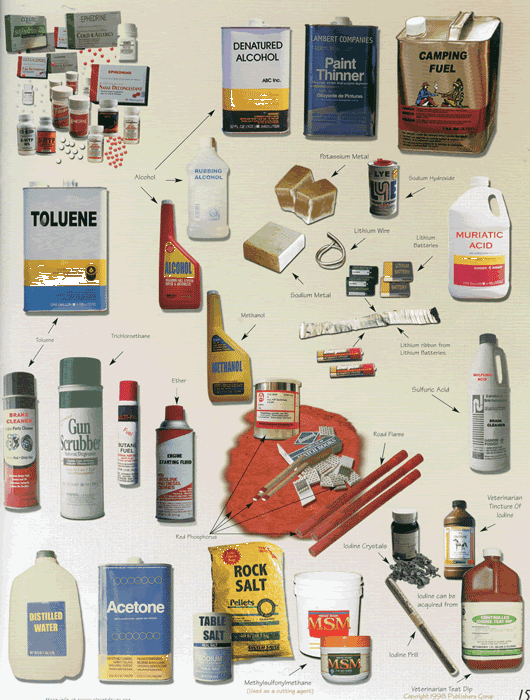Crystal Meth Help
Crystal Meth Effects and Symptoms
- Crystal Meth Effects
- Crystal Meth Withdrawal Symptoms
- Crystal Meth Symptoms
- Crystal Meth Side Effects
- Crystal Meth Overdose
- Injecting Meth
- Ingesting Meth
- Smoking Meth
- Meth and HIV
Crystal Meth Information
- Crystal Meth Addiction Treatment
- Crystal Meth Statistics
- Crystal Meth Facts
- Crystal Meth Prices
- Crystal Meth Street Names
- Crystal Meth Pictures
- Crystal Meth User Pictures
- Teen Meth Addiction
- Meth Addiction
- Drug Rehab for Meth Addiction
- Meth Intervention
Crystal Meth News
Crystal Meth Ingredients
Crystal Meth ingredients are typically legal and useful items in their own right. But when mixed together and processed incorrectly, the results are deadly to the "Crystal Meth cook", user, and innocent bystanders. Chemical ingredients and equipment used to "cook" Crystal Meth in illegal makeshift labs create an immediate danger of explosion and fire. This process also leaves behind waste that contaminates the site; often a house, apartment, or other dwelling. Crystal Meth labs and their ingredients pose a threat both to the environment and the health of future occupants.
Methamphetamine is closely related to amphetamine but has longer lasting and more toxic effects on the user's system. Crystal Meth is a white, odorless powder that dissolves easily in water or alcohol. Production of the drug begins with common chemicals, including EPHEDRINE or PSEUDOEPHEDRINE. By 2004, more and more Americans were expressing their concern over the ease with which these Crystal Meth ingredients could be purchased. Ephedrine-containing pills and powders were banned by the U.S. Food and Drug Administration (FDA) in 2004. However, as of mid-2005, illicit supplies were still available through the Internet. Pseudoephedrine is a key ingredient in cold medicines and asthma drugs.
Crystal Meth is relatively easy to produce in homemade laboratories. Various newspaper accounts note that Crystal Meth cooks routinely brew small batches of the drug in their home labs using household goods that they purchased legally in stores. Many use recipes they find on the Internet posted by amateur chemists. As such, the strength and toxicity of each batch can vary considerably depending on what Crystal Meth ingredients were used.
Common Crystal Meth Ingredients:

- 2-liter bottles
- Acetone
- Alcohol
- Anhydrous ammonia
- Battery acid
- Benzene
- Blenders
- Bronchodialators
- Camera batteries
- Camp stove fuel
- Chloroform
- Cold tablets
- Diet aids
- Drain cleaner
- Energy boosters
- Ephedrine
- Ether (starting fluid)
- Freon
- Gasoline additives/Rubbing Alcohol
- Hot plates
- Iodine
- Iodine crystals
- Lithium from batteries
Crystal Meth Lab Equipment:
- Muraitic acid
- Paint thinner
- Phenylacetone
- Phenylpropanolamine
- Pheynl-2-Propane
- Propane cylinders
- Red Devil Lye
- Red Phosphorous
- Rock, table, or Epsom salt
- Sodium metal
- Stained coffee filters
- Toluene (found in brake cleaner)
- Tubing
- Unmarked mason jars with tubes attached
- White gasoline
- Wooden matches

